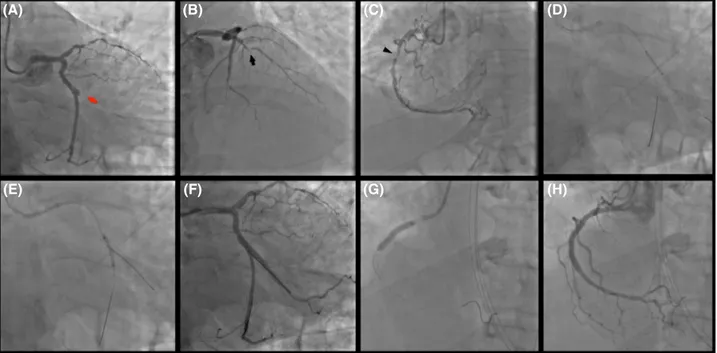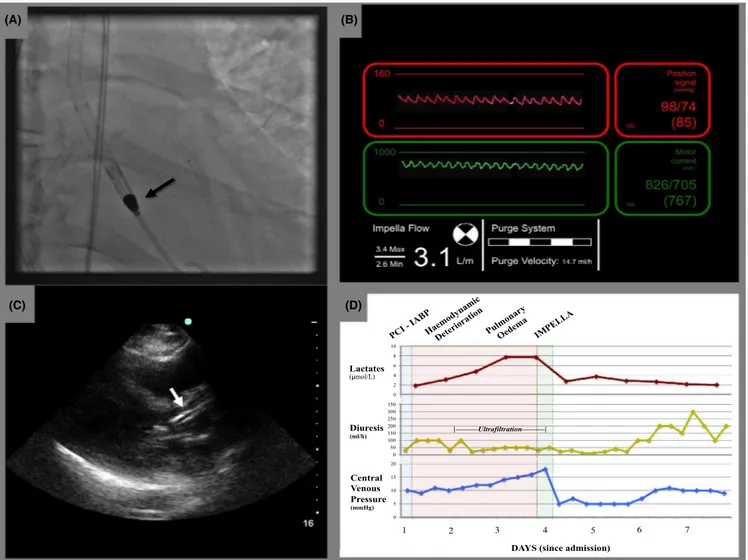Clin Case Rep. 2019;7:1469–1472. wileyonlinelibrary.com/journal/ccr3
|
14691
|
INTRODUCTION
Cardiogenic shock (CS) may complicate ST‐segment ele-vation myocardial infarction (STEMI) and is associated with a high fatality rate. Hemodynamic failure during CS represents a downward spiral in which myocardial ischemia drives to myocardial dysfunction, which, in turn, worsens myocardial and systemic ischemia. Intra‐aortic balloon pump (IABP) did not prove effective in this scenario1,2 as
more solid mechanical circulation support (MCS) devices are probably needed to revert the hemodynamic instabil-ity of CS. We describe the hemodynamic and metabolic changes of switching from IABP to a new percutaneous axial pump (ie, IMPELLA‐CP) in a patient with refractory cardiogenic shock after STEMI.
2
|
CASE REPORT
A 59‐year‐old man with no prior history of cardiovascular disease presented severely ill with oppressive chest pain during the last 6 hours and signs of inferolateral STEMI with cardiogenic shock. Reported cardiovascular risk fac-tors were hypertension and diabetes mellitus. Emergent coronary angiography showed thrombotic occlusion of the first obtuse marginal, a chronic occlusion of the left anterior descending coronary artery and a long stenosis of the proximal right coronary artery. Revascularization of the marginal branch and the right coronary artery was performed, and IABP was placed without complications (Figure 1). After revascularization, blood pressure persisted low (80/60 mm Hg) despite escalating inotropic treatment,
Received: 30 April 2019
|
Accepted: 23 May 2019 DOI: 10.1002/ccr3.2261C A S E R E P O R T
Impellent impeller—Switching intra‐aortic balloon pump to
IMPELLA‐CP after ST‐segment elevation myocardial infarction
and refractory cardiogenic shock
Marco Contarini
1|
Francesco Costa
2|
Maria Victoria Garcia Ruiz
3|
Renato F. M. Scalise
2|
Giovanni De Velli
1|
Paola Murè
1|
Paolo Mazzone
2|
Giorgio Sacchetta
1|
Giuseppe Andò
2This is an open access article under the terms of the Creative Commons Attribution License, which permits use, distribution and reproduction in any medium, provided the original work is properly cited.
© 2019 The Authors. Clinical Case Reports published by John Wiley & Sons Ltd. 1Interventional Cardiology Unit, Umberto I
Hospital, Syracuse, Italy
2Department of Clinical and Experimental Medicine, Policlinico "Gaetano
Martino", University of Messina, Messina, Italy
3UGC del Corazón, Servicio de
Cardiología, Hospital Clínico Universitario Virgen de la Victoria, Málaga, España
Correspondence
Francesco Costa, Interventional Cardiology Unit, Policlinico “Gaetano Martino”, Messina, Italy.
Email: [email protected]
Abstract
Cardiogenic shock is a dreadful complication of myocardial infarction. Despite widespread use and availability, intra‐aortic balloon pump (IABP) does not reduce mortality nor improves outcomes. Advanced mechanical circulatory support with IMPELLA system can substantially support hemodynamics and improve short‐term prognosis in patients with myocardial infarction and cardiogenic shock.
K E Y W O R D S
cardiogenic shock, IMPELLA, intra‐aortic balloon pump, left ventricle assist device, ST‐segment elevation myocardial infarction
1470
|
CONTARINI eTAl.diuresis was reduced (<10 mL/h) and lactate levels increas-ing (>7 μmol/L), thus configurincreas-ing a refractory cardiogenic shock (INTERMACS class 2).2 Symptoms of incipient
pulmonary edema persisted despite diuretic treatment and ultrafiltration. Left ventricle function was poor (LVEF <20%). In light of the worsening conditions, we decided to remove the IABP and switch it with an IMPELLA‐CP (Abiomed Inc). The IMPELLA‐CP was placed percutane-ously without complications, and correct positioning was confirmed by fluoroscopy and echocardiography. The per-fusion parameters demonstrated a good pump function with a stable flow between 3.0 and 3.5 L/min.
In the days after IMPELLA‐CP placement, we observed a progressive improvement of the hemodynamic and labora-tory parameters (Figure 2). Lactate levels decreased, spon-taneous diuresis recovered, and central venous pressure was maintained in the region of 10 mm Hg to guarantee an ad-equate preload. Left ventricle contractile function gradually improved (LVEF ≈ 30%) due to reduced afterload. Patient was progressively weaned from the device that was ulti-mately removed 10 days after implantation.
3
|
DISCUSSION
The present case highlights the metabolic and hemodynamic changes during the transition from a failing IABP to the IMPELLA‐CP system in the treatment of a refractory CS.
Cardiogenic shock complicating STEMI can persist de-spite optimal revascularization due to temporary myocardial stunning and is associated with an extremely high mortality risk.3-5 Since this condition might be reversible in days/weeks
after the initial injury, an active hemodynamic support during this phase is required. IABP has been used for decades to treat cardiogenic shock; however, solid evidence from ran-domized clinical trials failed to demonstrate a benefit from its routine use.1 The use of more effective MCS devices, like the
first‐generation IMPELLA which allows a flow up to 2.5 L/ min, might intuitively improve the hemodynamic status in cardiogenic shock. However, IMPELLA and other MCS de-vices failed to improve short‐term survival in early studies of patients with CS.3
The new IMPELLA‐CP is an evolution of the first‐gen-eration device and guarantees a maximal flow up to 4.0 L/ min. This axial pump is inserted through a 14F introducer in the femoral artery and actively aspirates blood from an inlet cage in the left ventricle, expelling it in the ascending aorta. From a mechanistic standpoint, the main advantage of IMPELLA‐CP is the ability to unload the left ventricle reducing end‐diastolic pressure and myocardial oxygen de-mand, increasing cardiac output, coronary flow, and sys-temic perfusion. IMPELLA is more versatile as compared to other MCS devices, has a more favorable learning curve, and can be independently managed by the cath laboratory staff. This is particularly convenient in smaller centers and in remote areas that cannot rely on advanced perfusion
FIGURE 1 Primary Intervention: thrombotic occlusion of the first obtuse marginal (culprit lesion—red arrow) (A); chronic occlusion at the mid‐segment of the left anterior descending coronary artery (black arrow) (B); long lesion of the proximal right coronary artery (arrow‐head) (C). Two overlapping drug‐eluting stents in the main branch were used to treat the culprit at bifurcation (D) with provisional technique (E, F). Right coronary artery was treated with two overlapping drug‐eluting stents (G, H)
(A) (E) (B) (F) (C) (G) (D) (H)
|
1471CONTARINI eTAl.
systems, where such devices might be used as a bridge to hemodynamic stability or to allow transportation to a ter-tiary center.4 Nevertheless, it remains controversial whether IMPELLA‐CP may reduce mortality.5 Indeed, rigorous
ran-domized clinical in this setting is extremely challenging to be carried out due to both the elevate complexity of the CS treatment and the ethical issues.
4
|
CONCLUSION
We report the hemodynamic and metabolic changes during the switch from IABP to IMPELLA‐CP in a patient with STEMI complicated by refractory CS. The new IMPELLA‐ CP provided superior hemodynamic support as compared to IABP and may represent a good tool in the early manage-ment of CS. However, the clinical benefit of MCS devices to reduce mortality during CS has yet to be demonstrated.
CONFLICT OF INTEREST
None declared.
AUTHOR CONTRIBUTIONS
MC: performed the case, drafted, and revised critically the manuscript. FC: drafted and revised critically the manuscript. VGR: revised critically the manuscript. RS: revised critically the manuscript. GDV: revised critically the manuscript. PM: revised critically the manuscript. PM: revised critically the manuscript. GS: performed the case, drafted and revised criti-cally the manuscript. GA: drafted and revised criticriti-cally the manuscript.
ORCID
Giuseppe Andò https://orcid.org/0000-0001-5552-6382
FIGURE 2 IMPELLA‐CP placement: IMPELLA‐CP was easily placed through the aortic valve and the pigtail end in proximity of the apex of the left ventricle (A). Good positioning and function were confirmed by satisfactory pressure waves at the device console (B) and by transthoracic echocardiography (C). Lactates, diuresis, and central venous pressure significantly improved after IMPELLA‐CP placement (D)
0 2 4 6 8 10 0 50 100 150 200 250 300 350 0 5 10 15 20 Central Venous Pressure (mmHg) Diuresis (ml/h) Lactates ( mol/L) | | 1 2 3 4 5 6 7
DAYS (since admission)
(A) (B)
1472
|
CONTARINI eTAl.REFERENCES
1. Thiele H, Zeymer U, Neumann F‐J, et al. Intraaortic balloon sup-port for myocardial infarction with cardiogenic shock. N Engl J Med. 2012;367(14):1287‐1296.
2. Holman WL, Kormos RL, Naftel DC, et al. Predictors of death and transplant in patients with a mechanical circulatory sup-port device: a multi‐institutional study. J Heart Lung Transplant. 2009;28(1):44‐50.
3. Cheng JM, den Uil CA, Hoeks SE, et al. Percutaneous left ventricu-lar assist devices vs. intra‐aortic balloon pump counterpulsation for treatment of cardiogenic shock: a meta‐analysis of controlled trials.
Eur Heart J. 2009;30(17):2102‐2108.
4. Beurtheret S, Mordant P, Paoletti X, et al. Emergency circula-tory support in refraccircula-tory cardiogenic shock patients in remote
institutions: a pilot study (the cardiac‐RESCUE program). Eur
Heart J. 2013;34(2):112‐120.
5. Ouweneel DM, Eriksen E, Sjauw KD, et al. Percutaneous mechanical circulatory support versus intra‐aortic balloon pump in cardiogenic shock after acute myocardial infarction. J Am Coll Cardiol. 2017;69(3):278‐287. How to cite this article: Contarini M, Costa F, Garcia
Ruiz MV, et al. Impellent impeller—Switching intra‐aortic balloon pump to IMPELLA‐CP after ST‐ segment elevation myocardial infarction and refractory cardiogenic shock. Clin Case Rep. 2019;7:1469–1472. https ://doi.org/10.1002/ccr3.2261

